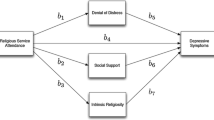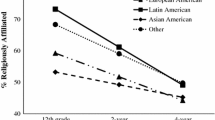Abstract
Over the past decade, US adolescents’ depressive symptoms have increased, and changing religious beliefs and service attendance may be contributing factors. We examined the contribution of religious factors to depressive symptoms among 417,540 US adolescents (grades: 8, 10, 12), years:1991–2019, in survey-weighted logistic regressions. Among adolescents who felt religion was personally important, those who never attended services had 2.23 times higher odds of reporting depressive symptoms compared to peers attending weekly. Among adolescents who did not feel that religion was important, the pattern was reversed. Among adolescents, concordance between importance of religion and religious service attendance may lower risk of depressive symptoms. Overall, we estimate that depressive symptom trends would be 28.2% lower if religious factors had remained at 1991 levels.


Similar content being viewed by others
Data Availability
Data are available through Monitoring the Future, which is largely publicly available.
Code Availability
SAS code is not available, kept in secure data enclave under MTF guidance.
References
Ang, Y. S., Lockwood, P., Apps, M. A. J., Muhammed, K., & Husain, M. (2017). Distinct subtypes of apathy revealed by the apathy motivation index. PLoS ONE. https://doi.org/10.1371/journal.pone.0169938
Balbuena, L., Baetz, M., & Bowen, R. (2013). Religious attendance, spirituality, and major depression in Canada: A 14-year follow-up study. Canadian Journal of Psychiatry. https://doi.org/10.1177/070674371305800408
Bonelli, R., Dew, R. E., Koenig, H. G., Rosmarin, D. H., & Vasegh, S. (2012). Religious and spiritual factors in depression: Review and integration of the research. Depression Research and Treatment. https://doi.org/10.1155/2012/962860
Bonelli, R. M., & Koenig, H. G. (2013). Mental disorders, religion and spirituality 1990 to 2010: A systematic evidence-based review. Journal of Religion and Health. https://doi.org/10.1007/s10943-013-9691-4
Braam, A. W., & Koenig, H. G. (2019). Religion, spirituality and depression in prospective studies: A systematic review. Journal of Affective Disorders. https://doi.org/10.1016/j.jad.2019.06.063
Coley, R. L., O’Brien, M., & Spielvogel, B. (2019). Secular trends in adolescent depressive symptoms: Growing Disparities between advantaged and disadvantaged schools. Journal of Youth and Adolescence. https://doi.org/10.1007/s10964-019-01084-1
Compas, B. E., Jaser, S. S., Bettis, A. H., Watson, K. H., Gruhn, M. A., Dunbar, J. P., Williams, E., & Thigpen, J. C. (2017). Coping, emotion regulation, and psychopathology in childhood and adolescence: A meta-analysis and narrative review. Psychological Bulletin. https://doi.org/10.1037/bul0000110
Cotton, S., Zebracki, K., Rosenthal, S. L., Tsevat, J., & Drotar, D. (2006). Religion/spirituality and adolescent health outcomes: A review. Journal of Adolescent Health. https://doi.org/10.1016/j.jadohealth.2005.10.005
Cragun, R. T., Kosmin, B., Keysar, A., Hammer, J. H., & Nielsen, M. (2012). On the receiving end: Discrimination toward the non-religious in the United States. Journal of Contemporary Religion. https://doi.org/10.1080/13537903.2012.642741
Dew, R. E., Fuemmeler, B., & Koenig, H. G. (2020). Trajectories of religious change from adolescence to adulthood, and demographic, environmental, and psychiatric correlates. The Journal of Nervous and Mental Disease. https://doi.org/10.1097/NMD.0000000000001154
Dew, R. E., Daniel, S. S., Armstrong, T. D., Goldston, D. B., Triplett, M. F., & Koenig, H. G. (2008). Religion/spirituality and adolescent psychiatric symptoms: A review. Child Psychiatry and Human Development. https://doi.org/10.1007/s10578-007-0093-2
Fruehwirth, J. C., Iyer, S., & Zhang, A. (2019). Religion and depression in adolescence. Journal of Political Economy. https://doi.org/10.1086/701425
Garssen, B., Visser, A., & Pool, G. (2021). Does Spirituality or Religion Positively Affect Mental Health? Meta-analysis of Longitudinal Studies. The International Journal for the Psychology of Religion, 31(1), 4–20. https://doi.org/10.1080/10508619.2020.1729570
Hasin, D. S., Goodwin, R. D., Stinson, F. S., & Grant, B. F. (2005). Epidemiology of major depressive disorder: Results from the national epidemiologic survey on alcoholism and related conditions. Archives of General Psychiatry. https://doi.org/10.1001/archpsyc.62.10.1097
Hodges, S. (2002). Mental health, depression, and dimensions of spirituality and religion. Journal of Adult Development. https://doi.org/10.1023/A:1015733329006
Horwitz, A. G., Hill, R. M., & King, C. A. (2011). Specific coping behaviors in relation to adolescent depression and suicidal ideation. Journal of Adolescence. https://doi.org/10.1016/j.adolescence.2010.10.004
Johnston, L. D., Miech, R. A., O’Malley, P. M., Bachman, J. G., Schulenberg, J. E., & Patrick, M. E. (2019). Monitoring the Future: National survey results on drug use 1975–2018. 2018 Overview: Key findings on adolescent drug use. The National Institute on Drug Abuse at The National Institutes of Health. https://files.eric.ed.gov/fulltext/ED594190.pdf
Keyes, K. M., Gary, D., O’Malley, P. M., Hamilton, A., & Schulenberg, J. (2019). Recent increases in depressive symptoms among US adolescents: Trends from 1991 to 2018. Social Psychiatry and Psychiatric Epidemiology. https://doi.org/10.1007/s00127-019-01697-8
Koenig, H. G. (2018). Religion and mental health: Research and clinical applications. Elsevier Academic Press. https://psycnet.apa.org/record/2018-00765-000
Kreski, N., Chen, Q., Olfson, M., Cerdá, M., Hasin, D. S., Martins, S. S., Mauro, P. M., & Keyes, K. M. (2021). Adolescent time use and associations with depressive symptoms from 1991 to 2019 among US adolescents. American Journal of Epidemiology (Under Review).
Levin, J. (2010). Religion and mental health: Theory and research. International Journal of Applied Psychoanalytic Studies. https://doi.org/10.1002/aps.240
Li, S., Okereke, O. I., Chang, S. C., Kawachi, I., & VanderWeele, T. J. (2016). Religious service attendance and lower depression among women—a prospective cohort study. Annals of Behavioral Medicine. https://doi.org/10.1007/s12160-016-9813-9
Lu, W. (2019). Adolescent depression: National trends, risk factors, and healthcare disparities. American Journal of Health Behavior. https://doi.org/10.5993/AJHB.43.1.15
Luk, J. W., Gilman, S. E., Haynie, D. L., & Simons-Morton, B. G. (2018). Sexual orientation and depressive symptoms in adolescents. Pediatrics. https://doi.org/10.1542/peds.2017-3309
Maselko, J., Gilman, S. E., & Buka, S. (2009). Religious service attendance and spiritual well-being are differentially associated with risk of major depression. Psychological Medicine. https://doi.org/10.1017/S0033291708004418
Maslowsky, J., Schulenberg, J. E., O’Malley, P. M., & Kloska, D. D. (2014). Depressive symptoms, conduct problems, and risk for polysubstance use among adolescents Results from US national surveys. Mental Health and Substance Use Dual Diagnosis. https://doi.org/10.1080/17523281.2013.786750
Maslowsky, J., Schulenberg, J. E., & Zucker, R. A. (2014b). Influence of conduct problems and depressive symptomatology on adolescent substance use: Developmentally proximal versus distal effects. Developmental Psychology. https://doi.org/10.1037/a0035085
Miech, R., Keyes, K. M., O’Malley, P. M., & Johnston, L. D. (2020). The great decline in adolescent cigarette smoking since 2000: consequences for drug use among US adolescents. Tobacco Control, 29(6), 638–643. https://doi.org/10.1136/tobaccocontrol-2019-055052
Min, J., Ailshire, J., & Eileen, C. (2016). Social engagement and depressive symptoms: Do baseline depression status and type of social activities make a difference? Age and Ageing. https://doi.org/10.1093/ageing/afw125
Mojtabai, R., Olfson, M., & Han, B. (2016). National trends in the prevalence and treatment of depression in adolescents and young adults. Pediatrics. https://doi.org/10.1542/peds.2016-1878
Newcomb, M. D., Huba, G. J., & Bentler, P. M. (1981). A multidimensional assessment of stressful life events among adolescents: Derivation and correlates. Journal of Health and Social Behavior. https://doi.org/10.2307/2136681
Newcomb, M. D., Huba, G. J., & Bentler, P. M. (1986). Life change events among adolescents: An empirical consideration of some methodological issues. Journal of Nervous and Mental Disease. https://doi.org/10.1097/00005053-198605000-00004
Park, C. L. (2005). Religion as a meaning-making framework in coping with life stress. Journal of Social Issues. https://doi.org/10.1111/j.1540-4560.2005.00428.x
Reisner, S. L., Katz-Wise, S. L., Gordon, A. R., Corliss, H. L., & Austin, S. B. (2016). Social epidemiology of depression and anxiety by gender identity. Journal of Adolescent Health. https://doi.org/10.1016/j.jadohealth.2016.04.006
Schnittker, J. (2019). Religion, social integration, and depression in Europe: Evidence from the European Social Survey. Social Science and Medicine. https://doi.org/10.1016/j.socscimed.2019.112376
Siegel, K., Anderman, S. J., & Schrimshaw, E. W. (2001). Religion and coping with health-related stress. Psychology and Health. https://doi.org/10.1080/08870440108405864
Strawbridge, W. J., Shema, S. J., Cohen, R. D., & Kaplan, G. A. (2001). Religious attendance increases survival by improving and maintaining Good health behaviors, mental health, and social relationships. Annals of Behavioral Medicine. https://doi.org/10.1207/S15324796ABM2301_10
Twenge, J. M., Exline, J. J., Grubbs, J. B., Sastry, R., & Campbell, W. K. (2015). Generational and time period differences in American adolescents’ religious orientation, 1966–2014. PLoS ONE. https://doi.org/10.1371/journal.pone.0121454
Van Voorhees, B. W., Paunesku, D., Kuwabara, S. A., Basu, A., Gollan, J., Hankin, B. L., Melkonian, S., & Reinecke, M. (2008). Protective and vulnerability factors predicting new-onset depressive episode in a representative of US adolescents. Journal of Adolescent Health. https://doi.org/10.1016/j.jadohealth.2007.11.135
VanderWeele, T. J. (2017). Religion and health: A synthesis. In M. J. Balboni, & J. R. Peteet (Eds.), Spirituality and religion within the culture of medicine: From evidence to practice (pp. 357–401). Oxford University Press. https://psycnet.apa.org/record/2017-20091-021
VanderWeele, T. J., Jackson, J. W., & Li, S. (2016). Causal inference and longitudinal data: A case study of religion and mental health. Social Psychiatry and Psychiatric Epidemiology. https://doi.org/10.1007/s00127-016-1281-9
Wallace, J. M., Forman, T. A., Caldwell, C. H., & Willis, D. S. (2003). Religion and US secondary school students: Current patterns, recent trends, and sociodemographic correlates. Youth and Society. https://doi.org/10.1177/0044118X03254564
Funding
These analyses are funded by Grant R01DA048853 (PI: Keyes) and with support from the Columbia Center for Injury Science and Prevention (R49-CE003094). Additionally, Dr. Martins reports funding from Grant R01DA037866, and Dr. Hasin reports funding from Grant R01DA048860. Funders had no role in the conduct of research or the preparation of this article. Funders had no role in study design, in the collection, analysis and interpretation of data, in the writing of the article, or in the decision to submit it for publication.
Author information
Authors and Affiliations
Corresponding author
Ethics declarations
Conflict of interest
No potential competing interest was reported by the authors.
Ethical Approval
The Monitoring the Future study is approved by the IRB of University of Michigan.
Informed Consent
Parents were informed of the study and provided the option to decline participation on their child’s behalf.
Additional information
Publisher's Note
Springer Nature remains neutral with regard to jurisdictional claims in published maps and institutional affiliations.
Appendix
Appendix
See Fig. 3 and Tables 3, 4, 5, 6, 7, 8, 9 and 10.
Rights and permissions
About this article
Cite this article
Kreski, N.T., Chen, Q., Olfson, M. et al. Explaining US Adolescent Depressive Symptom Trends Through Declines in Religious Beliefs and Service Attendance. J Relig Health 61, 300–326 (2022). https://doi.org/10.1007/s10943-021-01390-8
Accepted:
Published:
Issue Date:
DOI: https://doi.org/10.1007/s10943-021-01390-8





